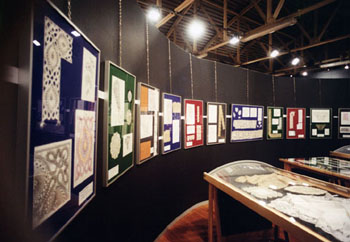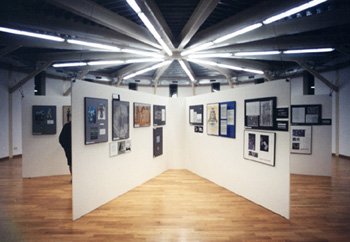4ª Biennial 1999
Cantù lace, like that of other important European “manufactures” in fact belongs to this category. These are small original masterpieces, which are definitely acquired to last, because they are an investment, not just in money, but above all in good taste, elegance and refinement, thus becoming, with these characteristics, part of what is nowadays called quality of life, and, in consequence, part of the historical memory of the family or the Institution which owns them.


Alongside the exhibition sections which have become traditional - the antique and contemporary lace exhibitions, and the Second International Competition for the design of an original bobbin lace work, this year we have set up a space dedicated to the exhibition of lace created, on commission from the Committee, on the basis of the prizewinning designs from the First International Competition which took place two years ago in the context of the Third Biennial.
It seems useful to point out the high number of submissions to the Second Competition (75 designs) and the enormous number of schools (53 participants) and private enthusiasts represented, of whom seven were from foreign countries. The prizes and commendations awarded to three non-Italian designs show the attention paid by foreign countries to the Cantù Competition, and on the other hand shows how other European countries are working intensely to update lace techniques and design.

As far as the artistic and scientific aspects of the initiatives are concerned, we must point out that the publication of the volume "Fili e parole. I merletti a fuselli: tradizioni e innovazioni” (“Threads and words. Bobbin lace: tradition and innovation") this year represented an event in itself. Most of the volume reports research which has involved lacemakers from all over Italy, in an effort to carry out a census of the interregional terminology for pillow lace. The attention paid by local media was significant, the press was informed by means of 400 press bulletins on the Internet (organized by ADN Cronos), subsequently 22 press folders were sent to women’s art and current affairs magazines of primary national importance. Roughly 20,000 visitors arrived from different parts of Italy (coaches arrived from Puglia, Friuli Venezia Giulia, Emilia Romagna, Piemonte and from various parts of Lombardy) and Europe, especially from Switzerland and Germany; we were particularly gratified by the presence of the Director of the Bruges Museum (Belgium) on the day of the inauguration, and by the Directors of the Modena Museum, and this clear appreciation decreed the success of the Cantù International Lace Biennial 1999.



